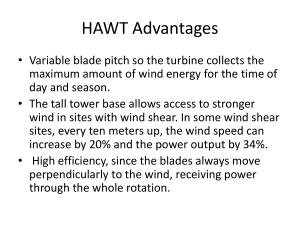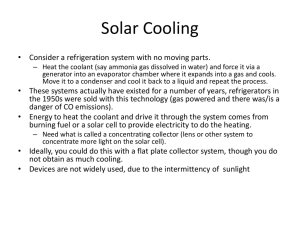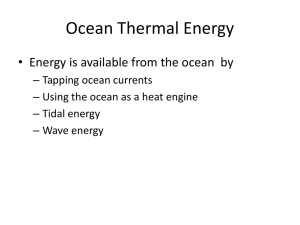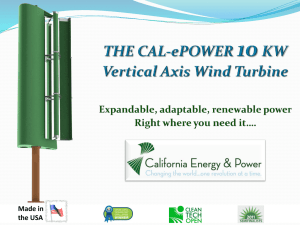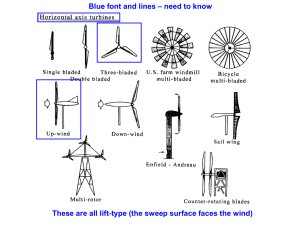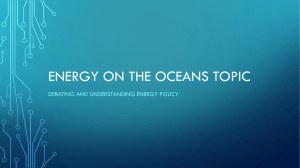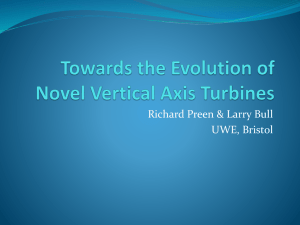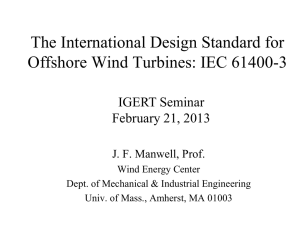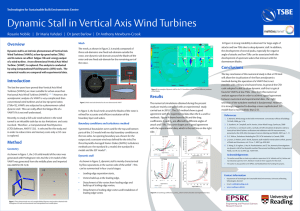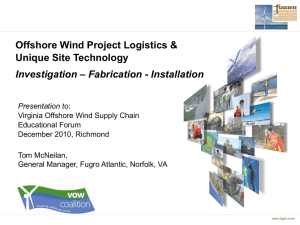HAWT Disadvantages
advertisement
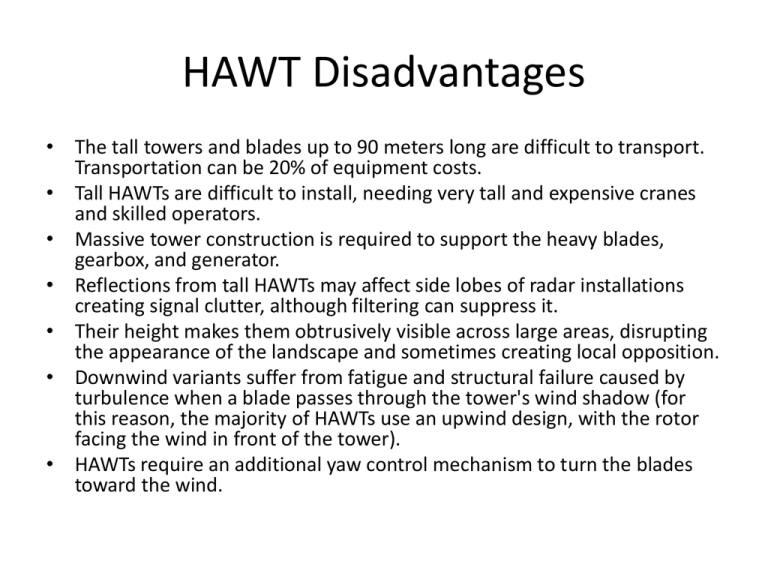
HAWT Disadvantages • The tall towers and blades up to 90 meters long are difficult to transport. Transportation can be 20% of equipment costs. • Tall HAWTs are difficult to install, needing very tall and expensive cranes and skilled operators. • Massive tower construction is required to support the heavy blades, gearbox, and generator. • Reflections from tall HAWTs may affect side lobes of radar installations creating signal clutter, although filtering can suppress it. • Their height makes them obtrusively visible across large areas, disrupting the appearance of the landscape and sometimes creating local opposition. • Downwind variants suffer from fatigue and structural failure caused by turbulence when a blade passes through the tower's wind shadow (for this reason, the majority of HAWTs use an upwind design, with the rotor facing the wind in front of the tower). • HAWTs require an additional yaw control mechanism to turn the blades toward the wind. VAWT • Vertical Axis Wind Turbines • have the main rotor shaft arranged vertically. • turbine does not need to be pointed into the wind to be effective. This is an advantage on sites where the wind direction is highly variable. • VAWTs can utilize winds from varying directions. Types of VAWT • • • Darrieus wind turbine – "Eggbeater" turbines. They have good efficiency, but poor reliability. Also, they generally require some external power source, or an additional Savonius rotor, to start turning. Giromill – A subtype of Darrieus turbine with straight, as opposed to curved, blades. The cycloturbine variety has variable pitch and is self-starting. – more efficient operation in turbulent winds; and a lower blade speed ratio which lowers blade bending stresses. Straight, V, or curved blades may be used. Savonius wind turbine – These are drag-type devices with two (or more) scoops that are used in anemometers, Flettner vents (commonly seen on bus and van roofs), and in some high-reliability low-efficiency power turbines. They are always self-starting if there are at least three scoops. They sometimes have long helical scoops to give a smooth torque. VAWT Advantages • • • • • • A massive tower structure is less frequently used, as VAWTs are more frequently mounted with the lower bearing mounted near the ground. A VAWT can be located nearer the ground, making it easier to maintain the moving parts. VAWTs have lower wind startup speeds than HAWTs. Typically, they start creating electricity at 6 m.p.h. (10 km/h). VAWTs may be built at locations where taller structures are prohibited. VAWTs situated close to the ground can take advantage of locations where mesas, hilltops, ridgelines, and passes funnel the wind and increase wind velocity. VAWTs may have a lower noise signature. VAWT disadvantages • • Most VAWTs produce energy at only 50% of the efficiency of HAWTs A VAWT that uses guy-wires to hold it in place puts stress on the bottom bearing as all the weight of the rotor is on the bearing. Guy wires attached to the top bearing increase downward thrust in wind gusts. Solving this problem requires a superstructure to hold a top bearing in place to eliminate the downward thrusts of gust events in guy wired models. • VAWTs' parts are located under the weight of the structure above it, which can make changing out parts nearly impossible without dismantling the structure if not designed properly. • Because VAWTs are not commonly deployed due mainly to the serious disadvantages mentioned above, they appear novel to those not familiar with the wind industry. This has often made them the subject of wild claims and investment scams over the last 50 years. Efficiencies based on blade type Overall Criticisms of Wind Turbines • wind power is an intermittent power source. The production from a wind turbine may increase or decrease dramatically over a short period of time with little or no warning. In the absence of large scale energy storage, the balance of the grid must be able to quickly compensate for this change. A proposed solution is a super grid of wind farms. • Economics: high quality wind resources are often located in areas inhospitable to people, logistics and transmission capacity can introduce significant obstacles to new installations. • The impact of wind turbines on wildlife has often been cited as a disadvantage of wind installations. Wind turbines can pose a danger to birds and bats, though the magnitude and gravity of this danger may be much less than threats such as house cats or plate glass. Wind Farms • A group of turbines in the same location • 3 types: – Onshore- within 30km of the shore line – Near shore -within 3km of the shoreline or 10 km offshore – Off shore -more than 10Km from land • Noise is a big issue for onshore and near shore, as is aesthetics Offshore wind farms Offshore wind farms • • • • • • • • • • less obtrusive than turbines on land apparent size and noise is mitigated by distance. the average wind speed is usually considerably higher over open water. Offshore installation is more expensive than onshore Offshore towers are generally taller than onshore towers once the submerged height is included. Offshore foundations may be more expensive to build. Power transmission from offshore turbines is through undersea cable Offshore saltwater environments also raise maintenance costs by corroding the towers, but fresh-water locations such as the Great Lakes do not. Turbine components (rotor blades, tower sections) can be transported by barge, making large parts easier to transport offshore than on land, where turn clearances and underpass clearances of available roads limit the size of turbine components that can be moved by truck. Similarly, large construction cranes are difficult to move to remote wind farms on land, but crane vessels easily move over water. Offshore wind farms tend to be quite large, often involving over 100 turbines. Cape Wind Project • • • • • • • • • • Approved offshore wind farm off of Cape Cod, MA. 130 wind turbines would produce a maximum of 454 MW enough power for 420,000 homes. Would provide 75% of the electrical needs to Cape Cod. and the Islands Concerns included ruining the views from people's private property. Views from public property such as beaches (even though it would be about twenty or so miles offshore, people complained it would ruin their views of the horizon). decrease property values. ruining popular areas for yachting. the proposed wind farm would be located near shipping lanes. Local fishermen, cite the fact that for many of them, up to 60% of their annual income comes from catch caught on Horseshoe Shoals, which they claim would disappear and would have to be replaced by steaming to fishing grounds farther out to sea if the project is completed. Some who oppose the project are concerned about the corporate privatization of public property. Interesting co-generation idea with cars and wind turbines • Turbines suspended over highways. • Each turbine can light a medium size apartment TVA wind farm near Oak Ridge Ocean Thermal Energy • Energy is available from the ocean by – Tapping ocean currents – Using the ocean as a heat engine – Tidal energy – Wave energy Energy from ocean currents • • • • • • Ocean currents flow at a steady velocity Place turbines in these currents (like the gulf stream) that operate just like wind turbines Water is more than 800 times denser than air, so for the same surface area, water moving 12 miles per hour exerts about the same amount of force as a constant 110 mph wind. Expensive proposition Upkeep could be expensive and complicated Environmental concerns – – – species protection (including fish and marine mammals) from injury from turning turbine blades. Consideration of shipping routes and present recreational uses of location Other considerations include risks from slowing the current flow by extracting energy. The ocean as a heat engine • There can be a 20° difference between ocean surface temps and the temp at 1000m • The surface acts as the heat source, the deeper cold water acts as a heat sink. • Temperature differences are very steady • Florida, Puerto Rico, Hawaii and other pacific islands are well suited to take advantage of this idea. • Called OTEC (Ocean Thermal Energy Conversion) Types of Ocean heat engines • Closed cycle system • Heat from warm seawater causes a fluid like ammonia to be evaporated in an evaporator • Expanding vapor rotates a turbine connected to an electric generator. • Cold seawater is brought up and cools the ammonia vapor in a condenser. This liquid returns to the evaporator and the process repeats. Types of OTECs • Open Cycle Systems • Working fluid is the seawater. • Warm seawater is brought into a partial vacuum. • In the vacuum, the warm seawater boils and the steam drives a turbine • The steam enters a condenser, where it is cooled by cold seawater brought up form below and it condenses back into liquid and is discharged into the ocean. Boiling water in a vacuum • The boiling point of any liquid depends upon temperature and pressure. • Boiling occurs when the molecules in the liquid have enough energy to break free from surrounding molecules • If you reduce the pressure, you reduce the amount of energy needed for the molecules to break free. • Creating a vacuum reduces the air pressure on the molecules and lowers the boiling point. OTECs • Carnot Efficiency is low, only about 7% • Net efficiency even lower, only about 2.5% • Low efficiencies require large water volumes to produce appreciable amount of electricity • For 100 mW output, you would need 25 X 106 liters/sec of warm and cold water. • For a 40 mW plant, a 10 meter wide intake pipe is needed. This is the size of a traffic tunnel. History of OTECs • Jacques d ‘Arsonval in 1881 first proposed the idea • Completed by his student, Georges Claude in 1930. (Claude also invented the neon lightbulb) • Claude built and tested the first OTEC system • Not much further interest until the energy crisis of the 1970s. • In the 1970s, US DOE financed large floating OTEC power plant to provide power to islands • One was built in Hawaii. • Little further support OTEC Plant on Keahole Point, Hawaii Other uses for OTEC plants • Generate Hydrogen for use as a clean fuel source • Generate fertilizer from biological nutrients that are drawn up from the ocean floor in the cold water intake. • Source of ocean water to be used as drinking water via desalination (taking out the salt).
